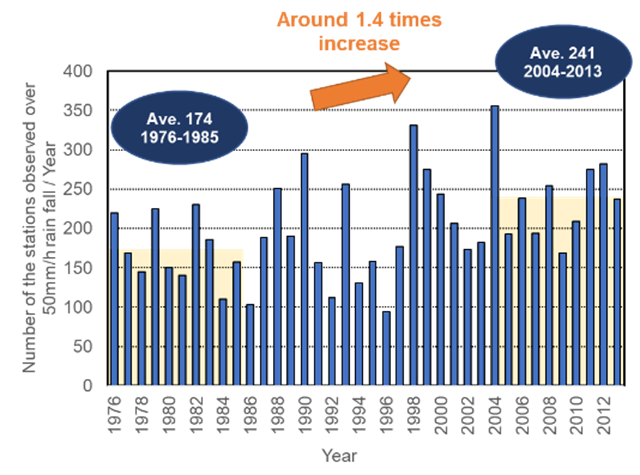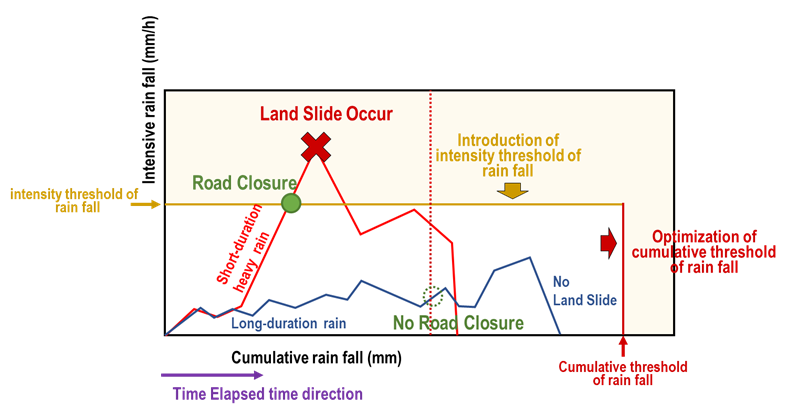
Disaster Management Manual
A manual for practitioners and decision makers!

Disaster Management Manual
A manual for practitioners and decision makers!
Road traffic closure and control have a great impact on local life and economic activities. Therefore, ensuring the functioning of roads is an important mission of road administrators. On the other hand, it is also an important mission of road managers to secure road safety and road users by controlling or closing the road traffic when there is a concern about safe road use such as during adverse weather conditions. In recent years, due in part to the effects of climate change, there has been an increase in localized and concentrated heavy rainfall in short periods. One of the important issues for road administrators is to prevent road users from being involved in landslides and other accidents caused by such extreme weather, especially during extreme torrential downpours. According to this background, it has been widely considered to restrict the use of roads in advance in order to ensure the safety of road and road users.
In Japan, based on the above concept, since 1969, pre-event road closures and traffic control systems have been implemented by designating areas where damage may occur or is likely to occur in the event of adverse weather conditions. When the threshold of extraordinary weather conditions is exceeded, road administrators close the road or control the traffic in order to ensure the safety of road and road users 1. In this section, an overview of Japan's pre-event road closures and traffic control system for heavy rainfall is introduced.
In Japan, the designation of pre-event traffic control and closure sections began in the late 1970s. In 1977, the peak year, 224 sections of 1,379 km were designated. As of April 2015, 980 km of 175 sections have been designated as pre-event traffic control and closure sections.
On the other hand, rainfall is becoming more localized and concentrated, according to the fact that the amount of rainfall exceeding 50 mm per hour, which is known as short-time torrential downpours, has increased 1.4 times in the last 30 years as shown in Figure 3.4.4.1. As a result of these changes in the weather, there has been an increase in the number of disasters such as landslides caused by sudden heavy rainfall and road closures, which have not been seen in the past. Therefore, it is necessary to improve the thresholds for pre-event traffic control and closure sections to cope with short-term torrential downpours 2.

Figure 3.4.4.1 shows the annual number of occurrences of hourly precipitation of 50 mm/h or more in Japan (per 1000 observation points) 3.
The following two methods are used to set the threshold for pre-event road closure and traffic control against heavy rainfall.
A road closure is imposed when the accumulated rainfall exceeds a threshold value. If there is no rainfall or very little rainfall (e.g., less than 2 mm per hour) for a certain period of time (often 3 hours), the accumulated rainfall is reset to zero. Figure 3.4.4.2 shows the schematic image of the cumulative rainfall method 5.

Since this is a relatively simple regulation based only on the cumulative rainfall, it is easy to predict the beginning time of the road closure, and it is relatively easy to deploy personnel and equipment for the road closure. On the other hand, since rainfall intensity cannot be reflected in the criteria, it is difficult to deal with disasters caused by localized or concentrated heavy rainfall in a short period of time.
The combination of cumulative rainfall and intensity of rainfall is used to deal with localized and concentrated heavy rainfall in a short period of time, which is difficult to deal with by the cumulative rainfall method, by setting the hourly rainfall as a reference value. Figure 3.4.4.3 shows the schematic image of the combination method of cumulative rainfall and intensity of rainfall 5.

The reference value is initially set by calculating the probability of rainfall based on 20 years of rainfall data and then adjusted (up or down) to the appropriate value based on the relationship between the experienced rainfall and the occurrence of disasters.
In this way, it is possible to set a standard value that corresponds to localized and concentrated heavy rainfall in a short period of time. On the other hand, in order to operate the system properly, it is necessary to have a sufficient observation system in place, including personnel and equipment, to immediately control the traffic.
In Japan, the cumulative rainfall method has been used for national and local roads, and the combined cumulative rainfall and intensity of rainfall method has been used for expressways.
The latter method, which incorporates hourly rainfall as an indicator, could be an effective means of dealing with disasters associated with localized torrential downpours. According to the investigation on the effect of this method on the national and local road, it was found that the disaster capture rate would be improved by 20% and the wrong capture rate would be reduced by 20-30%. Therefore, the implementation of the advanced traffic control system using this method is progressing 4.
In order to implement pre-event road closure or traffic control, it is necessary to have on-site personnel to actually implement the closure, which has been one of the issues. When implementing traffic control in advance of a disaster, accident, etc., or due to extreme rainfall, there is an increasing number of cases where automatic (remote-controlled) road closure measure is implemented by remote control while checking safety using CCTV cameras, etc. Currently, the system is used as a supplementary measure until the designated personnel arrives at the site, but further studies are being conducted based on the characteristics of the system that allows for quick implementation of road closure measures 2. Figure 3.4.4.4 4 shows the sequence of the road closure operation using automatic road closure measures 7.

In recent years, in addition to the concept of "pre-event road closure or traffic control," the system of "advance notice road closure or traffic control" is also under consideration. In Japan, railroad sector, when a typhoon is approaching and other factors are expected to affect train operations, advanced noticed suspensions have been implemented since 2014 in order to ensure passenger safety from disasters and prevent confusion 8, 9. In the case of a typhoon in 2018, some expressways were closed with advance notice 10.